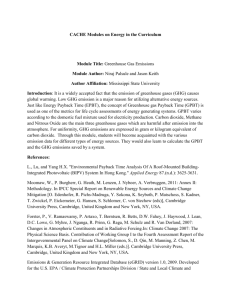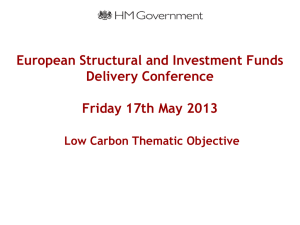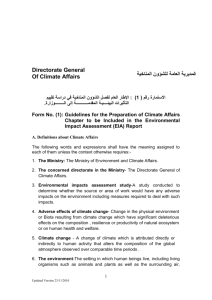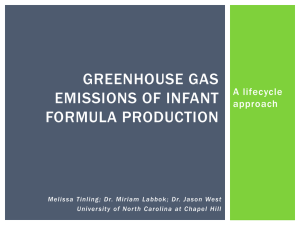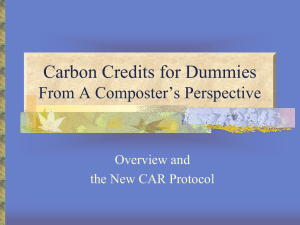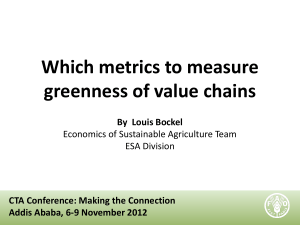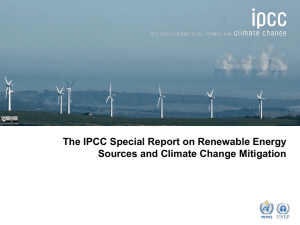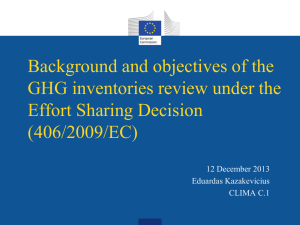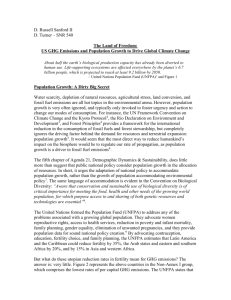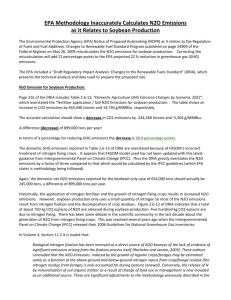GHG emissions of biomass: Consequence of
advertisement
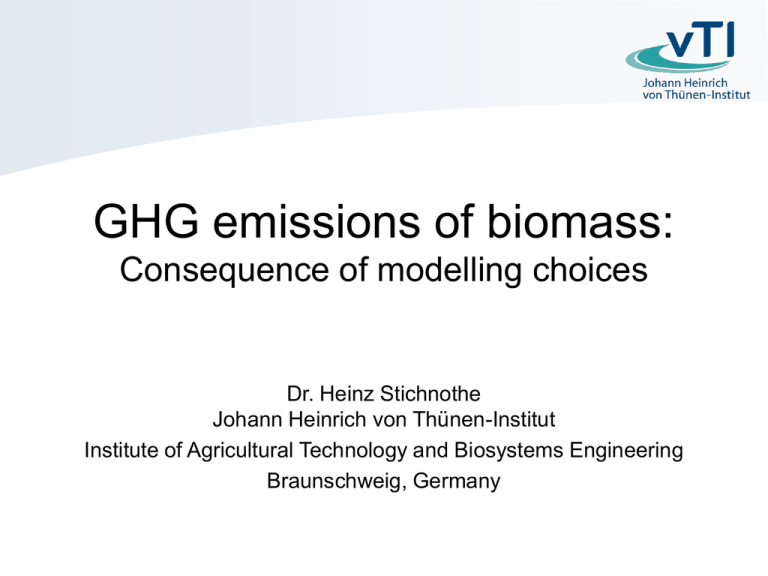
GHG emissions of biomass: Consequence of modelling choices Dr. Heinz Stichnothe Johann Heinrich von Thünen-Institut Institute of Agricultural Technology and Biosystems Engineering Braunschweig, Germany Outline • • • • • • • Methodological approaches Basis of comparison and allocation Indirect Emissionen (default values) Lack of knowledge Bio-based economy - limited resource Limits Conclusions Life cycle of biofuels RM Co-products Transp. Field Transp. Convers. Transp. Use Waste management Land use change Methodological approaches • Attributional LCA direct impacts due to diesel, fertiliser and pesticide use standardised procedure (system boundaries, allocation, etc.) used for product declaration and certification systems Advantage: comparable Disadvantage: blind spots • Consequentional LCA studies the consequences of change activities in- and outside the LC effected by changes are investigated includes alternative uses of constrained production factors Advantage: more complete Disadvantage: less precise Basis of comparison • Carbon intensity per energy output • Annual emissions Not suitable for material use Cascade use (all burdens to first life) Catch crops, crop rotation shift of emissions Allocation • Energy content • Exclusion of agricultural co-products Specialities of palm oil • Used as food, raw material and energy source • Yield (PO 3.7, rapeseed 0.6; soja 0.4 t/ha) • World production 45-50 Mt • 86% occurs in Malaysia and Indonesia • Export (approx. 80%) • 250.000 ha/a 3. GHG-emitter Agricultural residues EU-RED Annex 5 (18) Exclusion of nut shells, husk, etc Input Process Output Diesel Pesticides 22 kg Plantation Fertilizer FFB 1000 kg Products Compost CPO Diesel Oil mill Water Kernel By-Products 230 kg 0.07 L Diesel EFB Fibre Shells POME 650 kg Electr . Steam Energy Shells carrier Emissions Compost plant Biogas plant Biogas Power plant 8.7 m ³ CH 4 Compost 92 kg Ash Air Water Soil CH4 from POME • Default value 27 g/MJ (1.5 times higher) • CH4 capture - Yes or no • No difference between flaring and utilisation • Use of biogas hampered by exclusion of by-products (nut shells) • Efficiency of biogas capture is not considered (THREAT: leackage can outbalance the benefits) Biowaste management Biowaste “treatment” on palm oil plantations GWP from EFB [CO2eq/ t FFB] 300 250 35% GHG reduction 200 150 50% reduction 100 50 0 0% 10% 20% 30% 40% 50% 60% 70% 80% 90% Anaerobic condition in the pile 1 t FFB = 0.2 t palm oil; 150 – 1125 kg CO2eq. per t Palm oil 4 – 30 g CO2eq/MJ Biodiesel: 37 g CO2eq/MJ Currently not specified in palm oil production systems according to EU-RED 100% Indirect emissions • Nitrogen fertiliser production 18 g N2O per kg N (average without N2O removal) • After implementation of catalytic N2O reduction measures in Western Europe 9 g N2O per kg N (current average) • Technically possible 3 g N2O per kg N (future average in Western Europe) In comparison approx. 10 g N2O is formed per kg N applied Emission intensive fertiliser production is treated preferentially if Global default values are used; consequently GHG reduction from imported biomass might be overestimated Direct emissions • Organic Nitrogen is currently excluded in GHG calculations(examples in Annex V) • IPCC 2006 Guidelines (table 11.1), the default emission factor is 1% of applied (inorganic and organic) N. Example total N demand per t palm oil: 25 kg N, thereof 3,7 kg „returned“ 15% N input is not considered and consequently nitrous oxide from this input is also not taken into account Advantage: Nutrient recycling is fostered; simplified approach Disadvantage: GHG emission savings are overestimated Land use change - Indonesia 5 4,9 Assuming 100 t CO 25/ha 252eMt= CO Mit 100 t CO Mt=CO 50% 2e THG LW in D. 2e/ha = 2e = 50% GHG German agriculture Area [M ha] 4 3,7 3,3 4,4 3,9 3,4 3,0 3 2,5 2 1,2 1 0,7 0 1990 1995 2000 2001 2002 2003 2004 2005 2006 2007 Context 20000 Palm oil [1000*t] 18000 16000 14000 12000 10000 8000 16% 9% 6% 1% 6000 4000 55% 2000 38% 6% 0 Indonesia Malaysia 18075 16100 India/China 14150 EU-27 EU-Food EUIndustry EU-Energy 5400 2988 2100 312 Limited resource - Oil Limited resource - P Limits • National versus international responsibility who is contributing what to which extent • Influence sphere • Default values versus „real values“, management practise • Lack of knowledge – organic nitrogen, soil carbon • Focus on GHG blind spots • Crude oil and phosphorous are limited Conclusions • Do we want to be accurate or comparable? Indirect land use change, soil carbon storage • Technology - European average values for developing countries? • Right incentives for imported biomass? • Simplification - overestimation of savings • For imported biomass Learning curve yes, but GHG savings?
